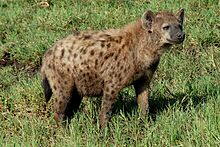
Spotted Hyena (Crocuta crocuta)
description of the animal
|
Information: Spotted hyenas reach a body length 125-160 cm, the tail is 22 to 27 centimeters relatively short. The shoulder height is 77-81 inches. The weight is usually 45 to 55 kilograms, individual animals can weigh up to 86 kilograms. [1] Females are larger than males by about 10%, but this sexual dimorphism varies regionally in southern Africa is more pronounced than in other regions of the continent. The coat is relatively short and rough, the long dorsal mane the other hyena species are absent in the spotted hyena. The relatively fine wool hairs are 15 to 20 millimeters long, coarse hairs mm 30 to 40. The basic color of the fur is sandy yellow to reddish-brown, the back, flanks and legs are numerous black and dark brown spots. They are brownish with age or may fade. As with all hyenas, the front legs are longer and stronger than the back legs, causing the back drop to the rear. The front and hind legs each terminate in four toes with blunt, non-retractable claws are provided. Like all hyenas are spotted hyenas digitigrad (his toes). The tail ends in a black, bushy top, her hair extend beyond the end of the tail about 12 centimeters. Glands on both sides of the anal canal but a secretion from the anal sacs located between the anus and tail. For this anal sacs in the area marking the secretion is released. The females usually have only one pair, rarely two pairs of teats. The males lacking, as in all the hyenas penis bone. Spotted hyenas are in much of Africa south of Sahara is home, her range extends from the Sahel to South Africa. In western Africa, the distribution is fragmented, the way there is hardly found outside protected areas. In large parts of eastern and southern Africa, the distribution is continuous. The largest populations live in the East African Serengeti and Kruger National Park. Area, they are extinct, such as in Algeria, where they lived in the mountains n'Ajjer Ahaggar and Tassili, or in central and southern Africa. In some regions they return, however, it was Ivindo National Park in Gabon beginning of the 21st Century, the first animal sighted for about 50 years. Their food ranges from caterpillars to elephants, they are opportunistic and consume nearly all mammals, birds, reptiles and fish species found in their habitat. Birds' eggs - which they occur and do not bite - are also on their menu such as flying insects that they catch from the air, occasionally they also eat vegetable matter. Most places, however, the medium-sized to large ungulates dar. the main component of the diet in East Africa are the blue wildebeest, zebras, gazelles and antelopes lyre, in the dry southern African Oryx, impala in the Kruger National Park and western Africa Rotstirngazellen and hartebeest.
|
Short Poems - William Shakespeare
